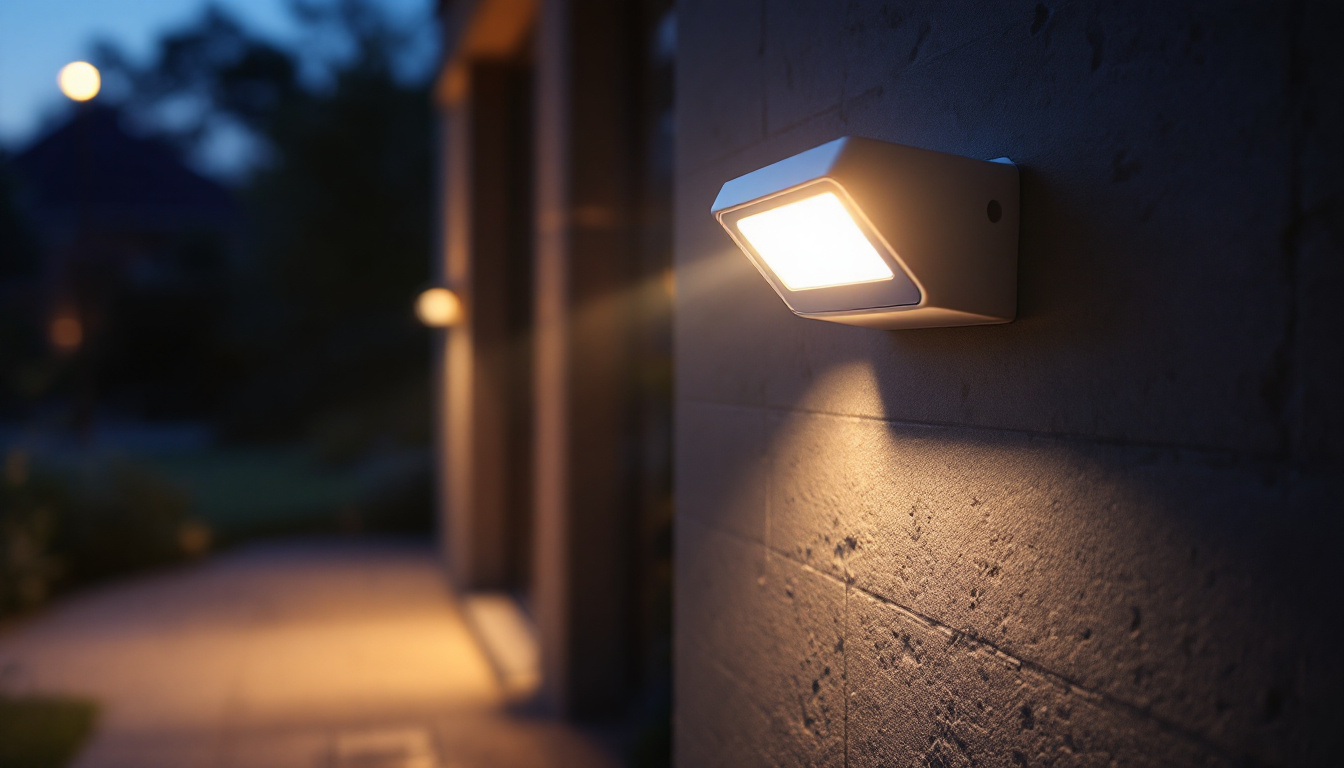
In the realm of outdoor lighting, the choice between motion outdoor lights and their alternatives is a critical decision for lighting contractors. As the demand for energy-efficient, secure, and aesthetically pleasing outdoor spaces grows, understanding the nuances of these lighting options becomes essential. This article delves into the advantages and disadvantages of motion outdoor lights compared to other lighting solutions, providing insights to help contractors make informed choices for their clients.
Motion outdoor lights are designed to illuminate areas when movement is detected. These lights are equipped with sensors that activate the illumination, providing both security and convenience. The technology behind motion sensors has evolved, making these lights more reliable and efficient than ever before.
At the heart of motion outdoor lights is the sensor technology that detects movement. Most commonly, these sensors utilize passive infrared (PIR) technology, which detects changes in heat emitted by objects. When a person or animal enters the sensor’s range, the light turns on, providing illumination for a predetermined period before shutting off.
Some advanced models also incorporate dual technology, combining PIR with microwave sensors to enhance detection capabilities. This dual approach minimizes false alarms and ensures that the lights activate only when necessary, thereby conserving energy. Additionally, some systems allow for adjustable sensitivity settings, enabling homeowners to customize how responsive their lights are to movement, which is particularly useful in areas with frequent animal activity.
One of the primary advantages of motion outdoor lights is their ability to enhance security. By illuminating pathways, driveways, and entry points only when movement is detected, these lights deter potential intruders and provide peace of mind to homeowners. Additionally, they save energy by operating only when needed, making them an eco-friendly option.
Moreover, motion lights can improve safety. Homeowners and guests are less likely to trip or fall in poorly lit areas when these lights activate, creating a more welcoming environment. The convenience of not having to fumble for a switch in the dark adds to their appeal. Beyond safety and security, many modern motion outdoor lights come equipped with smart technology, allowing users to control them remotely via smartphone apps. This feature not only enhances convenience but also allows for scheduling and integration with home automation systems, enabling homeowners to create a cohesive and responsive outdoor lighting strategy.
While motion outdoor lights offer numerous benefits, there are several alternatives that lighting contractors may consider. Each option has its unique advantages and applications, making it essential to evaluate the specific needs of a project.
Traditional outdoor lighting solutions, such as floodlights and wall sconces, provide consistent illumination regardless of movement. These fixtures can be installed in various locations to create a well-lit environment throughout the night.
One of the main advantages of traditional lighting is its reliability. Homeowners can expect a constant light source that enhances visibility at all times. This is particularly beneficial in areas where security is a concern, as consistent lighting can deter criminal activity. Additionally, traditional outdoor lights can be designed to complement the architectural style of a home, offering both functionality and aesthetic appeal. Whether it’s a classic lantern style or a modern sleek design, these fixtures can enhance the overall curb appeal of a property.
Smart lighting technology has gained popularity in recent years, offering homeowners the ability to control their outdoor lights remotely through smartphone applications. These systems can be programmed to operate on schedules, adjust brightness levels, and even change colors, providing a customizable lighting experience.
Smart lights can also integrate with home security systems, allowing for synchronized operation with cameras and alarms. This feature adds an extra layer of security, as homeowners can receive alerts and control their lighting from anywhere. Moreover, many smart lighting solutions are compatible with voice-activated assistants, enabling hands-free control that enhances convenience. Imagine being able to say, “Turn on the porch lights,” as you approach your home, making it easier to navigate in the dark and ensuring a warm welcome for guests.
Solar-powered outdoor lights are an eco-friendly alternative that harnesses energy from the sun. These fixtures are equipped with solar panels that charge during the day, allowing for illumination at night without relying on the electrical grid.
Solar lights are particularly advantageous in remote areas where electrical installation may be challenging or costly. They require minimal maintenance and can be easily relocated, making them a flexible option for various outdoor settings. Furthermore, advancements in solar technology have led to more efficient and brighter LED options, allowing homeowners to enjoy high-quality lighting without the environmental impact. Many solar lights now come with features such as motion sensors and dusk-to-dawn capabilities, ensuring they only operate when needed, thus maximizing energy efficiency. This combination of sustainability and practicality makes solar-powered lights an increasingly popular choice for environmentally conscious consumers.
When comparing motion outdoor lights to traditional lighting, smart solutions, and solar-powered options, several factors come into play. Each type of lighting serves different purposes and offers distinct advantages, making it crucial for contractors to assess the specific requirements of their projects.
Energy efficiency is a significant consideration for homeowners and contractors alike. Motion outdoor lights excel in this area, as they only activate when movement is detected, reducing unnecessary energy consumption. In contrast, traditional lighting remains on throughout the night, leading to higher energy costs.
Smart lighting solutions also offer energy-saving capabilities, allowing homeowners to set schedules and control their lights remotely. Solar-powered lights, while not reliant on electricity, may have limitations in terms of brightness and duration, particularly in regions with less sunlight.
The installation process varies significantly between motion outdoor lights and their alternatives. Motion lights typically require careful placement to ensure optimal sensor coverage, which may involve additional labor and planning. Traditional lighting, on the other hand, can be installed in a straightforward manner, providing consistent illumination without the need for sensor adjustments.
Maintenance is another critical factor. Motion outdoor lights may require periodic sensor cleaning and battery replacements for models that are not hardwired. In contrast, traditional lights may only need occasional bulb replacements, while solar-powered lights require maintenance of the solar panels to ensure efficiency.
Security is a primary concern for many homeowners, and motion outdoor lights are often viewed as a deterrent against intruders. Their ability to illuminate only when movement is detected can create an unpredictable environment for potential threats.
However, traditional lighting provides a constant source of illumination, which can also enhance security by ensuring that all areas are visible at all times. The choice between these options may depend on the specific security needs of the homeowner and the layout of the property.
As a lighting contractor, understanding the unique needs of each client is essential in making the right lighting choice. Factors such as the property layout, security concerns, and energy efficiency preferences should guide the decision-making process.
Begin by conducting a thorough assessment of the property. Identify areas that require illumination, such as pathways, entry points, and outdoor living spaces. Discuss with the client their priorities regarding security, energy efficiency, and aesthetics to determine the best lighting solution.
For clients who prioritize security, motion outdoor lights may be the ideal choice. However, if they seek consistent illumination for entertaining or outdoor activities, traditional lighting or smart solutions may be more suitable.
Budget is often a significant factor in the decision-making process. Motion outdoor lights may have a higher upfront cost due to the sensor technology, but they can save money in the long run through energy efficiency. Traditional lighting may be more budget-friendly initially, but ongoing energy costs should be considered.
Smart lighting solutions and solar-powered options can also vary widely in price, and contractors should present clients with a range of options that fit their budget while meeting their needs.
As technology continues to evolve, future-proofing lighting installations is becoming increasingly important. Smart lighting solutions offer adaptability, allowing homeowners to upgrade their systems as new features become available. Motion outdoor lights, with their energy-saving capabilities, also align with the growing emphasis on sustainability.
Contractors should consider recommending systems that can be easily integrated with future technologies, ensuring that clients’ investments remain relevant and effective over time.
The choice between motion outdoor lights and their alternatives is not a one-size-fits-all decision. Each option presents unique benefits and challenges, making it essential for lighting contractors to evaluate the specific needs of their clients. By understanding the advantages of motion sensors, traditional lighting, smart solutions, and solar-powered options, contractors can provide tailored recommendations that enhance safety, security, and energy efficiency.
Ultimately, the right lighting solution will depend on a combination of factors, including client preferences, property layout, budget, and the desired level of energy efficiency. By staying informed about the latest advancements in outdoor lighting technology, contractors can ensure that they are well-equipped to guide their clients toward the best choices for their outdoor spaces.
Ready to elevate your outdoor lighting game? Look no further than LumenWholesale for a comprehensive range of spec-grade lighting products that blend quality with unbeatable wholesale value. Our selection is tailored to meet the highest industry standards, ensuring you deliver reliable and high-performance lighting solutions to your clients. Say goodbye to inflated markups and hello to hassle-free bulk buying with free shipping. Make the smart choice for your next project and experience the best value in wholesale lighting today.

Discover the essential checklist for lighting contractors working with LED drop ceiling lights.

Discover how partnering with top light bulb manufacturers can illuminate new business opportunities for lighting contractors.

Discover expert insights from lighting contractors on determining the perfect number of recessed lights for any space.

Discover how exterior security lights with motion sensors can enhance safety and efficiency in your lighting projects.